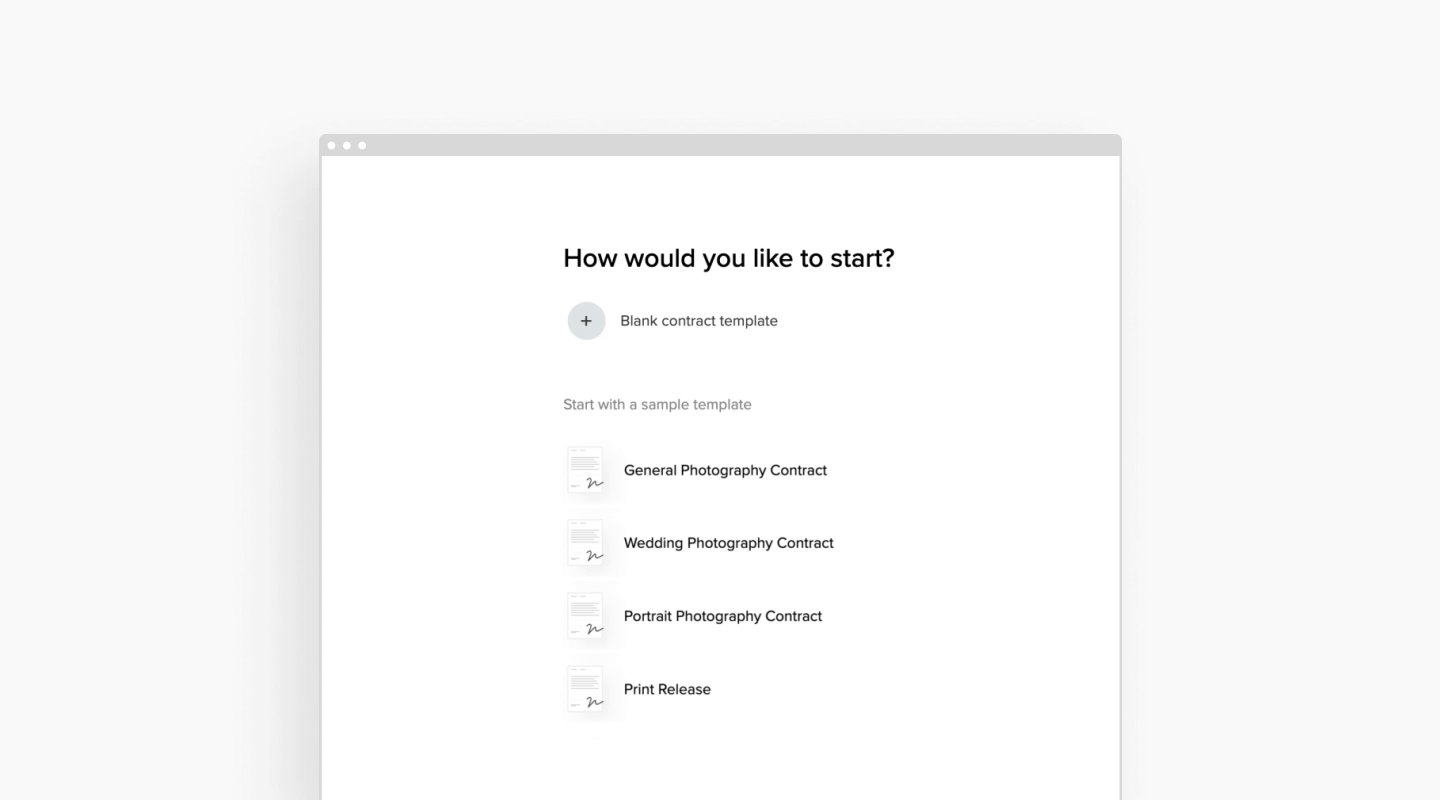BLOG
12 Essential things to include in your photography contract
As a new photographer, who can’t wait to turn your passion into a successful career, it’s often easy to overlook the importance of having a contract in place. We live in the era when partnerships are confirmed via dm’s and texts, and both parties hope that the other one will carry out their part of the deal. Yet things don’t always go according to plan. That’s why it is crucial to sign a contract with your clients.
In this article we’ll explain:
- why you need to use a contract for your photography business
- what you need to include in a contract
- which tool to use for creating and sending contracts to clients
- where to find free contract samples/examples for photographers

Why use a photography contract?
The most important reason why you, as a photography business, need contracts — is to protect yourself. Through a contract you can state clearly what will be delivered, what are the timeframes, what each party is responsible for, and what are the consequences if terms are broken. This helps set accurate expectations for both you and your client, as well as reduces misunderstandings.
Apart from the legal benefits, a contract positions you as a professional and helps build a trustworthy relationship with your client. If anything goes wrong, both of you have guarantees that your interests and rights are protected.
Finally, a contract serves as a detailed breakdown of what the client is paying for - your rates and extra fees. This minimizes surprises, confusion or frustration when the invoice arrives.

What to include in a photography contract | 12 important sections
Below we’ve compiled a list of essential clauses and details you’ll want to include into your photography contracts to protect your business, protect your intellectual property, as well as offer guidance for unforeseen events.
1. Names of Both Parties
Cover the basics - clearly state the parties involved. Include the names and contact details for each. If you’re an LLC or S-Corp, you’ll need to use your business name for this.
2. Engagement of Photographer (scope of service)
Describe the service you will provide, mention any important dates or timelines. Add crucial information for your clients to be aware of. Get as detailed as possible when writing out this section.
3. Photographer & Client Responsibilities
Setting clear expectations is the best recipe for a successful collaboration. Clarify what each is responsible for and has to deliver. For example, if you’re photographing a wedding in a venue or a national park, you need to mention that the client is responsible to obtain permits and confirm any restrictions. If you want them to cover travel expenses, location tickets, etc. - state it in your contract.
If you have a strict photo delivery schedule (i.e. all clients get a preview gallery 2 weeks after the shoot with an X amount of photos, and the full gallery within 2 months after the session with up to Y amount of photos) this is a good section to mention in your contract, so the client knows what to expect within their package and this agreement.
4. Payment Details & Other Fees
This is the part of the contract where you break down the costs, share payment terms and deadlines. Most photographers opt for a deposit/non-refundable retainer that is paid immediately after signing a contract. Afterwards, depending on the type of service you’re providing, you can either have a payment plan in place or share a deadline for the full payment. Any discounts, taxes, extra fees or à la carte options should also be listed out in this section.
It’s a good practice to include a note on what happens if the client fails to pay the invoice in a timely manner, or if a payment bounces.
Additionally, you can mention whether the client is subject to any penalty fees for arriving late to the session (i.e. if you have multiple mini-sessions planned for the day, this can really mess up your schedule) or if the client doesn’t show up for their session at all.
5. Ownership of Work & Client Usage Rights
This section explains who owns what and for how long. Depending on the nature of your service - portraits, weddings, commercial work, you can keep all copyrights and grant your client usage rights, or transfer all rights upon full payment.
Expand on who owns the photos, and how images can be used by each party. If you intend to share the images on your website, on social media, in a paid ad campaign, or submit them for publication - mention that in your contract. Similarly, you need to stipulate in which ways the client is allowed to use their images (think of personal vs commercial purposes).
6. Limitation of Liability & Indemnification
This clause protects you from unexpected circumstances or things that are beyond your control - illness, injury, natural disasters or other force majeure events (i.e. a pandemic). Share what steps will be taken if an emergency prevents you from performing the service / delivering the photos. Share an estimated timeline (i.e. will email the client within 24 hours), whether you will be providing a replacement photographer or refunding your client, and if it will be a full or partial refund.
It’s a good practice to also include an indemnification (compensation for harm or loss) section. It protects you from legal liability if a third party (your client’s child, grandma or dog) is harmed in any way during the photoshoot or if they damage any property at the location where you’re shooting.

7. Post-Production & Editing Policy (artistic release)
Add a detailed Editing Policy section in your contract. It will help you avoid having clients reach out with multiple retouch requests, or demand that you edit photos differently from your usual style. Describe the type of editing your client can expect for their photos, as well as whether they are allowed to perform any further edits on the photos themselves.
8. Releases & Waiver
Model and property releases can be separate forms or sections included in your contract as a waiver clause.
If you want to publicly share your photos - you need a release. A model release confirms that the person you photograph (clients, couples, models) allows you to publicly show their image. A property release is needed if you’re showcasing a private location on your images - a studio, an office, someone’s home, or even their pet (pets count as property). It’s always good to secure all necessary releases prior to a photo session, even if you don’t plan to use the photos for commercial purposes.
9. Photographer Exclusivity
This section allows you to confirm your priority/exclusivity over any other photographer at an event or photoshoot, including guests who may interfere and impede you from getting an important shot.
10. Meals & Breaks
A great clause to include into your contract if you photograph events or projects that take longer than 5-6 hours. Asking your client to provide a proper meal for you and your team is only reasonable. As well as share clear details on any breaks you and your team will take.
11. Cancellation, Refund & Rescheduling policy
Life happens, and sometimes a client may need to terminate their contract. In this section you can include what’s the timeframe for the client to deliver a notice, in order to get a partial or full refund. Can the session be rescheduled? Are there any fees applied? Can the deposit be used for a future session? Are there any penalty fees applied if the cancelation is last minute? Try to anticipate different scenarios and make sure that this clause covers them all.
12. Governing Law
This is especially important for destination photographers or those who work with international clients. The Governing Law clause states which legal code will be used to confirm the validity of the contract. Usually photographers use the laws of their own country/state. This protects you in the event when a client wants to sue you in their own country/state, where laws are in favor of your client’s claim.

How to create a contract for your photography service (tools & free contract templates)
Now that you know the most important items you need to include into your photography contract, you’re probably wondering - what tool should you use to create a contract?
We recommend you to sign up for Studio Manager. With the free plan you can create professional looking contracts and have clients sign them online, from any device. No paperwork, no headache and a super intuitive process. Check out a demo sample here.
You can create your own contracts and save them as templates for future, or pick one of the ready-made samples available inside the dashboard and adjust to your business needs. The built-in contract samples include all of the essential clauses described in this article. All you have to do is:
- Sign up for a free account
- Go to the Contracts tab and click on New Contract
- Select or add the client who will get the contract
- Choose a ready-made contract template and customize it, or create a new contract using our intuitive builder.
- Send the contract to your client.
- For more guidance follow this tutorial on how to create contracts using Pixieset Studio Manager.
Apart from contracts, Studio Manager allows you to create and send invoices, collect payments from clients (online and offline), send questionnaires and gather important information for your portrait, wedding, event or any other type of photo session. With the paid plan, you also get to enable automatic email follow-ups, document expiration dates, personalization options and more. Get started with a free plan to test out all the features - upgrade only when you need to.
DISCLAIMER: The tips listed out in this article are provided solely for your convenience and may not address your specific requirements. This article is not a substitute for legal advice. In furnishing this article, neither Pixieset nor its affiliates undertakes or agrees to any obligation to provide anyone with access to additional information or to update this article or to correct any inaccuracies in, or omissions from, this article. Any reader should contact his, her or their own legal adviser for legal advice. Pixieset and its affiliates disclaim any and all liability arising from or in connection with the use of this article (or any part thereof).


 Studio Manager
Studio Manager 
